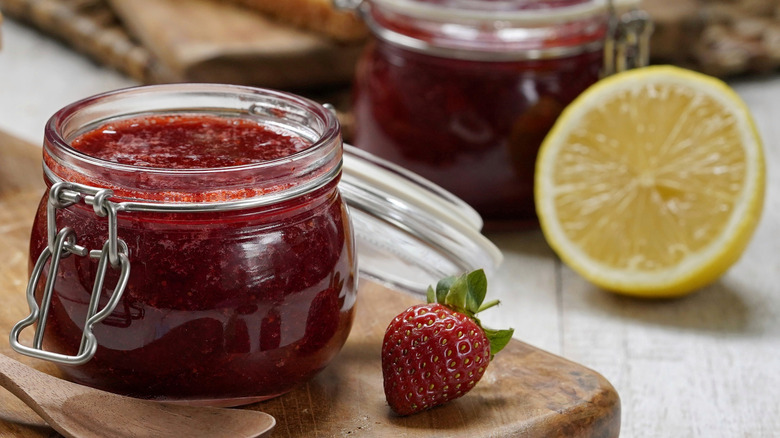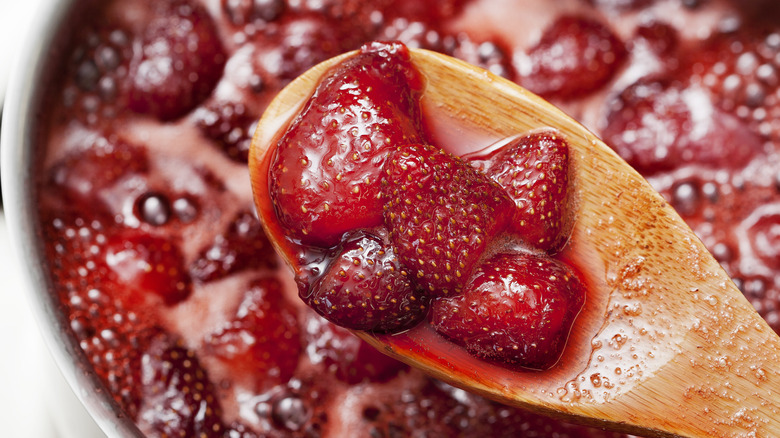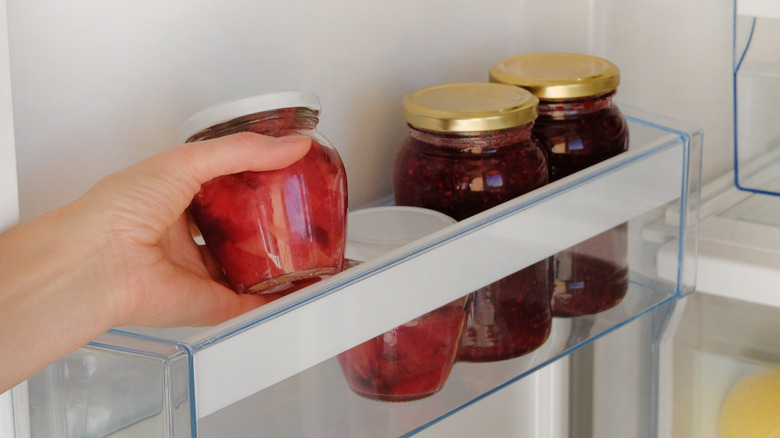The Lemon Juice Tip For Getting Your Homemade Jam's Texture Just Right
Whether it's made from tart raspberries, bright peaches, or sharp rhubarb, fresh fruit jam is the sweet and sticky condiment that holds a special place inside your kitchen. It gloriously lights up a slice of toast, a bowl of porridge, and even the humble sponge cake. Making homemade jam is a wholesome activity that is wonderfully rewarding ... If the jam sets correctly. Unfortunately, if you're left with a sloppy mess, your jammy dreams may feel thwarted. Don't lose hope. With a simple lemon juice trick, your homemade jam will achieve your desired thick texture.
Preparing jam is about capturing the sweet essence of the fruit while simultaneously cooking it down to the perfect syrupy consistency. Lemon is crucial to balancing those sweet flavors, but it also helps the pectin to firm up the jam. It can be added at the start of the cooking process or towards the end, but what must be taken into account is that adding liquids to the jam mixture will inevitably require the jam to cook for longer. In other words, you must cook off the excess fluid of the lemon to ensure the jam sets. Homemade jam is a labor of love that's worth every second. And once you understand the science behind the reasoning, you won't be able to stop yourself from adding a little lemon juice.
The science behind adding lemon juice to jam
While lemon juice's sour bite balances the sweet aromas of fresh fruit and sugar, the lemon juice's purpose inside jam goes far beyond this. While pectin is added to jam to speed up the thickening process, it is also essential to keep the fruit's bright and vibrant flavors and colors (which can dissipate over prolonged cooking times). For pectin to work as efficiently as possible, acidity can work wonders — which is where lemon juice comes in.
Depending on the fruit you've chosen for your jam, you may wonder why extra acidity — in this case, lemon juice — is needed. Fruits contain varying acidity levels, but this is usually not enough to reach the desired pH for the pectin chains to gel and set. The pectin molecule structure comprises COOH groups, which can be negatively charged, leading to a repulsion between molecules instead of solidification in the jam. Lemon juice raises the acidic pH of the jam and lowers these repulsive forces. Thus, the desired consistency is achieved. Adding more liquids to create a firm structure might sound like a jam paradox, but the evidence is all in the chemistry.
Adding the right amount of lemon juice for the perfect jam
The acidity of fresh lemon juice can vary from fruit to fruit, depending on its ripeness and how it's grown. In this sense, you may need to adjust how much you add to your jam to trigger the pectin to achieve the perfect set. Generally, it's advised to add one tablespoon of lemon juice per pound of fruit. However, if you follow the jam recipe closely, you may wish to use bottled lemon juice. Bottled lemon juice has a standardized level of acidity, so there'll be no question whether you've added enough.
Powdered acids like citric, malic, or tartaric can be used instead of juice. These are ideal alternatives if you're seeking a neutral flavor instead of citrus fruit's floral, sour taste. Using these also means you will not be incorporating extra water, so the added minutes used to reduce the excess liquid from the lemon juice can be cut. However, these acids are much more assertive and must be carefully measured before being added to the jam.
If you're wondering if your jam meets the ideal pH level to set, you can test it beforehand. If this isn't an option, you can always use a spatula hack to tell when your jam is done or pop it in the refrigerator for 24 hours to check if it's reached the desired consistency. Colder temperatures help the jam to thicken and form a firm texture.


